Minimalist Bookshelves: Design and Functionality
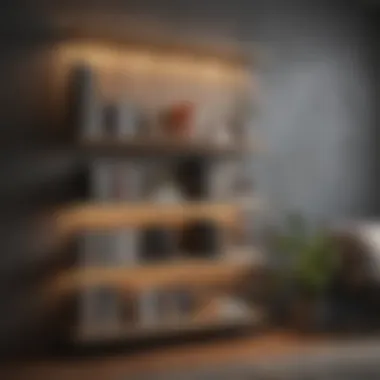
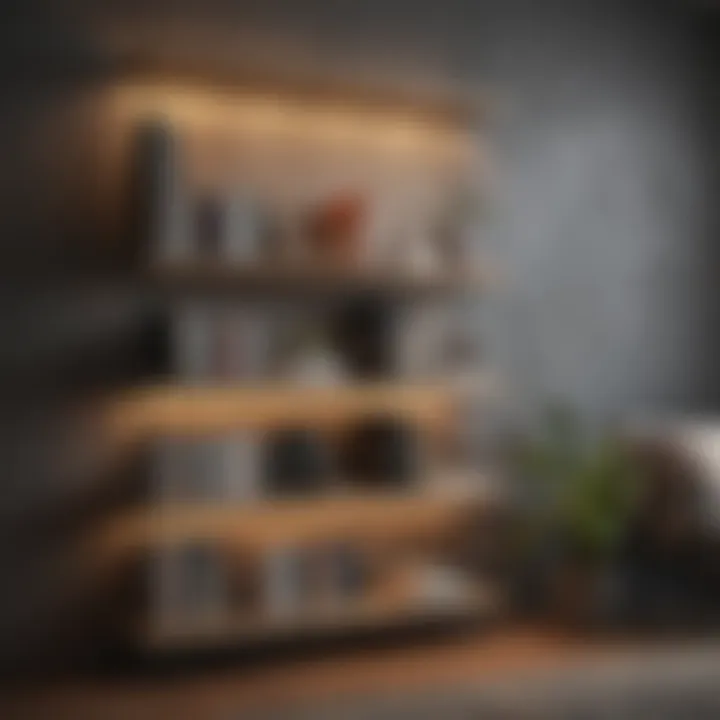
Intro
The world of interior design is always changing, and one trend that keeps raising eyebrows is the minimalist approach. Minamalist bookshelves are not just about keeping books off the floor; they represent a way of living that values simplicity and clarity. These bookshelves can be seen as modern art pieces, whether they are stark white, polished wood, or even metal accents. This article will guide you through the aesthetic and functional aspects of these bookshelves, bringing to light how they fit into both the practical and philosophical aspects of your home design.
Design Inspiration
If you’re looking to refresh your space, understanding the design inspiration behind minimalist bookshelves is a great start.
Trending Styles
Minimalism isn't just a concept; it has its styles, merging function and aesthetic in unique ways. Some popular styles include:
- Scandinavian: Characterized by light woods and clean lines, Scandinavian design promotes functionality while retaining a cozy feel.
- Industrial: Often using metal and reclaimed wood, this style embraces raw imperfections and offers a bold statement.
- Modern: Sleek surfaces and geometric shapes define modern minimalist bookshelves, often with open shelving to showcase both books and art.
These styles not only serve as functional furniture pieces, but they also provide a canvas to celebrate literature and art in an uncluttered manner.
Color Palettes
Color plays a crucial role in the design of minimalist bookshelves. Soft hues and neutral tones are often favored, as they help maintain a serene environment. Consider these popular palettes:
- Monochrome: Utilizing shades of black, white, and gray creates a timeless look, allowing your books to command attention without distraction.
- Soft pastels: Gentle shades like mint green or baby blue provide a touch of color without overwhelming the eyes, perfect for lightening up darker spaces.
- Earth tones: Rich browns or milky whites can bring warmth into a space while still adhering to minimalist principles.
Choosing the right colors infuses character while maintaining that essential sense of space and peace.
Practical Tips
Creating and maintaining a minimalist bookshelf does come with its challenges, but practical tips can smooth the process.
Maintenance & Care
To keep your minimalist bookshelf looking fresh and inviting, consider these maintenance strategies:
- Regular dusting: Use a soft cloth or microfiber tool to avoid dust buildup that can make even the sleekest design look dull.
- Organize regularly: Don’t let clutter accumulate. Periodically check on the arrangement of your books and items.
- Use proper lighting: Good lighting can enhance the appearance of your bookshelf. Overhead or spotlights draw attention to a well-curated selection without overshadowing it.
Budgeting & Planning
Budgeting is essential, especially if you’re looking at real wood or designer pieces. Here are a few budgeting strategies:
- Set a ceiling: Determine the maximum amount you're willing to spend.
- Explore second hand options: Thrift stores and online marketplaces can yield wonderful finds.
- DIY solutions: Sometimes the best design solution is the one you create yourself. Use simple materials to craft a bookshelf that fits your style and budget.
By understanding your design inspirations and having practical advice at your fingertips, you can curate a minimalist bookshelf that not only serves as a storage solution but also enhances your space stylistically.
The Essence of Minimalism
Minimalism transcends mere aesthetic appeal; it collects the very principles of clarity and functionality that can profoundly impact interior design. Understanding the essence of minimalism is pivotal when discussing minimalist bookshelves, as it links their design to a broader philosophical approach to living. The simplicity in form and function encourages a life free from the excess clutter, creating spaces that evoke peace and focus.
In a world where distractions abound, establishing simplicity is a breath of fresh air. The minimalist philosophy not only prioritizes appearance but also considers how furniture, like bookshelves, can aid in creating an inviting atmosphere without overwhelming one's space.
Defining Minimalism
At its core, minimalism is about stripping away the unnecessary to amplify what truly matters. This is not just about having fewer items; it's about making thoughtful choices that reflect personal values and lifestyle. When it comes to minimalist bookshelves, the focus shifts to functionality without compromising design. A minimalist bookshelf isn't just a place to store books; it is a curated collection that speaks to the owner's interests and ideals.
Defining minimalist design requires clarity in vision and purpose. Bookshelves, which are often underestimated in their design potential, can transform from mere storage solutions to remarkable design features. Here, minimalism embodies both restraint and elegance; no frills, just the essentials, skillfully arranged.
Historical Context and Evolution
The roots of minimalism can be traced back to various cultural and artistic movements. The Bauhaus school, emerging in the early 20th century, centered on the idea that form follows function. This notion paved the way for modern minimalist aesthetics we see in architecture and design today. As time went on, minimalism began to permeate other areas, such as art and music, showcasing the belief that less is more.
In the realm of furniture design, the 1950s and 60s saw a significant lean towards minimalist principles, with designers like Charles and Ray Eames championing items that were both practical and beautiful. This historical evolution has laid a solid foundation for the contemporary interpretations of minimalist bookshelves, encouraging designers and homeowners alike to focus on shape and material over decorative excess.
Minimalism in Contemporary Design
Today, minimalist design resonates with a growing audience, driven by a desire for sustainability and intentional living. Each piece of furniture, including bookshelves, is chosen not merely for its utility but for how it harmonizes within a space.
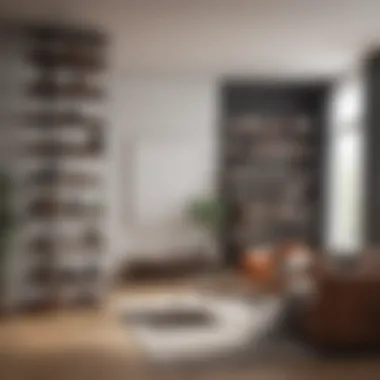
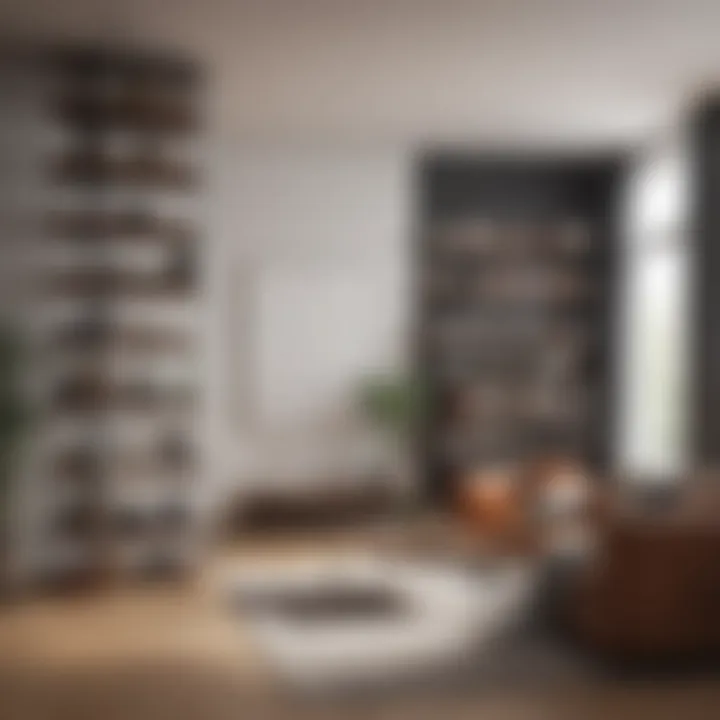
Contemporary minimalist bookshelves often utilize materials like bamboo, reclaimed wood, and metals, enhancing both aesthetic appeal and environmental consciousness. The designs aim to exude tranquility, making them ideal for spaces meant for reading, reflection, or even socializing.
"Simplicity is the removal of the useless and the unnecessary."
— Alberto Alessi
The blend of artistic expression with functional needs results in bookshelves that serve as conversation starters while maintaining an air of understated elegance. As the lines between work and home life blur, minimalist designs offer versatile options that adapt to any modern lifestyle.
Bookshelves as Design Elements
Bookshelves are often more than just functional storage units; they are pivotal elements that can influence the overall aesthetic of a space. When designed thoughtfully, a bookshelf can transform an ordinary room into a sophisticated and inviting environment. The conscious choice of bookshelf design can enhance both styling and storage capabilities in a home or office. By understanding how bookshelves contribute to aesthetics, homeowners and design enthusiasts can make informed decisions about these crucial pieces.
Role of Bookshelves in Interior Design
Bookshelves serve as a bridge between form and function. They provide physical support for books and decorative items, yet they can also play a huge role in defining the character of a room. A well-placed bookshelf can guide the flow of a space, directing the eye and creating zones within larger areas. For example, a tall, sleek, and open bookshelf might give a sense of verticality, making a room feel larger, whereas a low, wide shelf can create intimacy and warmth.
The way a bookshelf interacts with other elements in a room can also be telling. When combining it with neutral colors and organic shapes, it can promote a feeling of peace and calm. Alternatively, bold colors or intricate designs can inject a sense of excitement and dynamism into the room. It's essential to consider the balance between existing furniture and decor to achieve a harmonious look.
"A bookshelf isn't just about books; it's a storyteller in its own right, reflecting individual style and taste."
Functionality Versus Aesthetics
It's a tricky balancing act to merge functionality with aesthetics in bookshelf design. On one hand, you'll want a bookshelf that serves your storage needs effectively – that means having enough shelves to hold your collection without looking cramped. On the other hand, the look of the shelf shouldn’t be left in the dust.
Practical design choices can enhance both aspects:
- Use adjustable shelves to accommodate different book sizes and display items.
- Incorporate closed storage solutions to hide clutter, allowing the aesthetics of clean lines to shine.
- Think about how the bookshelf can act as a divider or a focal point, thus enhancing the visual interest without sacrificing purpose.
Ultimately, a successful bookshelf design will seamlessly blend both functionality and aesthetics. A homeowner should ask themselves: does this bookshelf not only house my books but also serve as an art piece that complements my style? The answer to this question will shape their choices in materials, colors, and placements within the space.
Principles of Minimalist Bookshelves
Minimalist bookshelves are not just furniture; they represent a philosophy that embraces simplicity while prioritizing function. This section seeks to unpack the principles that contribute to the aesthetic and functional prowess of minimalist bookshelves. Emphasizing clarity, these designs often result in a space that is deeply engaging yet uncluttered.
Simplicity in Design
When it comes to minimalist bookshelf design, less is certainly more. The core idea here is stripping away anything that doesn't serve a purpose or enhance the beauty of the space. This could mean selecting bookshelves with clean lines, neutral color palettes, and unembellished surfaces. The design should lend itself to allowing the books and other displayed items to shine, instead of overwhelming them.
Consider a floating shelf that snugly fits a few select books alongside a lone decorative item. This minimalist approach leads to a sense of calm and order, which can be particularly appealing to those juggling work and leisure within the same space. Designs incorporating geometric shapes tend to catch the eye without being over the top, allowing the viewer to appreciate the overall configuration rather than getting lost in ornate details. Simplicity breeds peace of mind, offering a tranquil space for reading or working.
Incorporating Negative Space
In the realm of minimalist design, negative space is just as important as the objects that fill it. The area around and between objects can create a visual balance that fosters a sense of tranquility within a space. Too many books crammed into a bookshelf can feel chaotic; instead, leaving space provides breathing room for the eyes.
Applying this principle, one can consider allowing gaps between books or leaving portions of shelves empty. This method not only enhances the overall aesthetics but also highlights the character of individual book covers and decorative items. It’s about creating a rhythm within the chaos.
Negative space is not just emptiness; it’s a vital element that contributes to the overall harmony of the design.
Material Selection and Its Impact
The materials used in creating minimalist bookshelves should echo the principles of simplicity and functionality. Common choices like wood, glass, and metals each offer their own sets of advantages. For instance, oak or maple can bring warmth to a room, while metal shelves may provide that sleek, industrial look. Glass shelves add a touch of refinement and lightness, often making a space feel larger and more airy.
When selecting materials, durability should not be overlooked. A bookshelf is ideally a long-term investment, and selecting high-quality materials can assure that it stands the test of time. Moreover, the finish applied to these materials can influence the way they reflect light and therefore impact the overall feel of the room. It's essential that the material selected does not just serve its purpose but also enhances the visual narrative the bookshelf aims to communicate.
Thus, the principles of minimalist bookshelves go beyond mere aesthetics; they delve deep into the intellect of design itself, blending utility with a refined sense of beauty.
Psychological Impacts of Minimalist Spaces
The significance of psychological impacts within the realm of minimalist spaces is profound, particularly when discussing the role of minimalist bookshelves. These storage solutions serve more than a practical purpose; they act as a framework for mental clarity and well-being. By reducing visual noise and maximizing open space, minimalist designs create a conducive environment for clear thinking and relaxation. Such benefits attract not only interior design aficionados but also those seeking to enhance their living environments. Minimalism engages the mind by fostering an atmosphere of tranquility, encouraging deeper focus while engaging with books and other materials.
Effects on Mental Clarity and Focus
Having an uncluttered, minimalist bookshelf directly influences one’s ability to concentrate. When the eye scans a room filled with knick-knacks and other assorted objects, it becomes a battle between stimuli. On the contrary, a well-selected array of books displayed sparsely provides a clean slate that invites calmness.
- Clarity of Thought: A tidy environment frees the mind of distractions. Embracing minimalism can help individuals to prioritize what truly matters, both within their bookshelves and lives. When surrounded by fewer possessions, it becomes easier to engage with essential ideas and themes.
- Enhanced Productivity: Studies hint at a direct correlation between organized spaces and improved focus. When you have fewer distractions, it allows for deeper immersion into tasks such as reading, studying, or working from home.
"In every room, you should be able to see the floor," says the famed interior designer, who emphasizes simplicity not merely as a style but as a pathway to clarity.
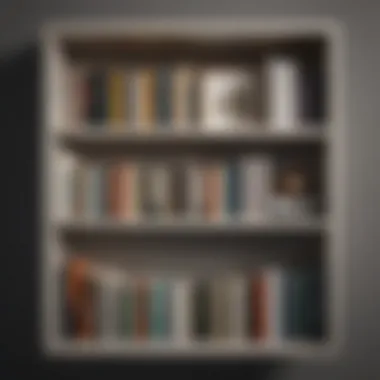
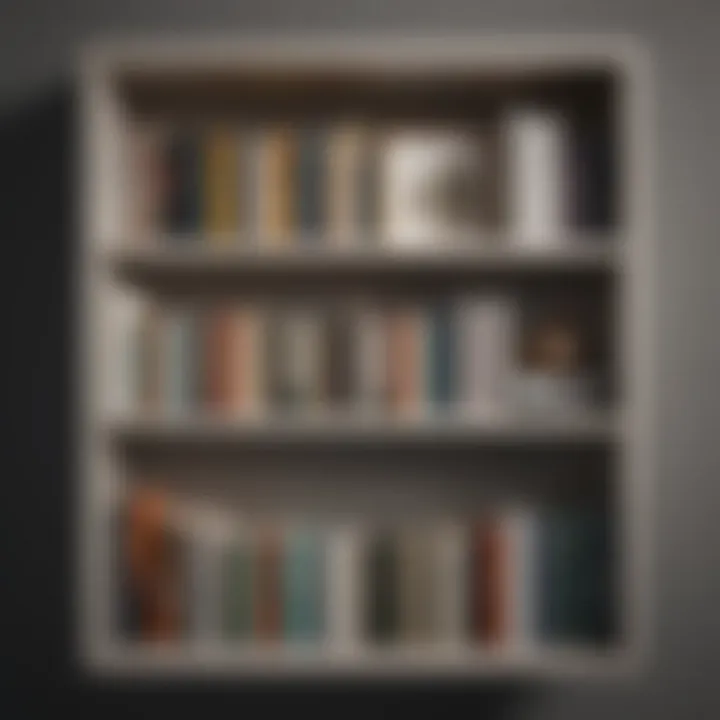
Reducing Clutter and Its Benefits
Reducing clutter within minimalist bookshelves extends beyond mere aesthetic appeal. It heralds a strategy for alleviating stress and fostering emotional well-being. The benefits of examining clutter in this light can be substantial:
- Emotional Freedom: An overflow of objects can lead to feelings of being overwhelmed, often reflecting unresolved emotional states. Minimalism, notably through curated bookshelves, frees us from these burdens.
- Simplified Decision-Making: With fewer items to choose from, making decisions becomes more straightforward. This clarity results in a more streamlined thought process.
- Space for Inspiration: A clean and organized bookshelf can serve as a canvas for creativity. With fewer distractions in sight, one can contemplate ideas more freely and imaginatively.
The reduction of clutter, therefore, cultivates an environment where focus thrives, aligning seamlessly with the principles of minimalist design. Recognizing these psychological impacts propels homeowners and enthusiasts alike toward embracing minimalist bookshelves not just as design elements, but as vital tools for enhancing cognitive health.
Curating a Minimalist Bookshelf
Creating a minimalist bookshelf is more than just arranging books; it's a thoughtful endeavor that reflects personal taste and lifestyle. Curating a minimalist bookshelf allows you to create a space that’s not only practical but also aesthetically pleasing, promoting a sense of calm and organization in your home. As you embark on this journey, consider the critical elements that will enhance your experience and elevate your environment.
Choosing What to Keep
Deciding which books to keep is an essential step in curating a minimalist bookshelf. The process begins with a thorough evaluation of your collection. Ask yourself: Which books resonate with you? Do you find joy in their pages and words? Begin the sorting process by separating cherished volumes from those you feel indifferent about.
Here are some guiding questions to filter your selection:
- Do I love it? If a book doesn’t elicit excitement or nostalgia, it might be time to let it go.
- Will I read it again? Consider whether you’ll revisit certain favorites.
- Does it serve a purpose? Practicality can weigh in, especially if reference material is frequently used.
Ultimately, choosing what to keep can feel like trimming excess from your life, paving the way for a cleaner, more organized space that speaks to your identity.
Display Techniques for Fewer Items
Once you have kept only the essential items, the next step is to think strategically about their display. Here’s where creativity shines. Minimalist design thrives on visual simplicity and balance. To achieve this:
- Adventure in layering. At times, stacking books horizontally can break up the vertical lines and add a dynamic feel.
- Incorporate bold colors or textures. Instead of a wall of books in muted tones, allow one or two striking book covers to stand out.
- Use varying heights. Position taller books next to shorter ones to create interest and movement.
Additionally, consider utilizing other materials like plants, decorative boxes, or personal art to intersperse amidst your books. These elements can enhance the look while reminding you of your interests or travels.
Integrating Personal Touches
A minimalist bookshelf should still reflect who you are. This is where you can weave in elements that add character—without overwhelming the space. Personal touches not only bring warmth but also create a sense of belonging in your curated selection.
Think about the following:
- Photographs or artwork. Integrating a small framed picture or a piece of art creates a focal point and invites conversation.
- Travel souvenirs. Items collected from trips serve as personal anecdotes and memories, keeping your shelf unique.
- Unique bookends. Select bookends that quietly showcase your style, whether they be sleek metal, carved wood, or even handmade items.
By harmonizing personal touches with your minimalist goals, you foster a bookshelf that resonates not only as a storage solution but as a true manifestation of your interests and experiences.
"Curating a minimalist bookshelf doesn’t just make for better organization; it incorporates a deeper understanding of what is essential and meaningful in your life."
As you put these elements into practice, your minimalist bookshelf will evolve into more than just an arrangement of items; it will become a curated reflection of your life. Choosing what to retain, using effective display techniques, and integrating personal mementos can transform an ordinary shelf into a thoughtful showcase of who you are.
Challenges of Minimalist Bookshelves
Minimalist bookshelves have a unique charm, blending form and function in a manner that often captivates the eye. However, designing and implementing them comes with its own set of challenges. Understanding these hurdles is crucial for homeowners and design enthusiasts alike, as overcoming these challenges not only enhances the aesthetic appeal but also ensures that the minimalist philosophy is respected in practice.
Overcoming Attachment to Objects
One major challenge many individuals face when transitioning to minimalist bookshelves is the emotional attachment to their possessions. Books, memorabilia, and other items often hold sentimental value, making it difficult to let them go. Additionally, the sheer volume of items one possesses can lead to a feeling of guilt about discarding beloved possessions. This emotional tug-of-war can be daunting.
A practical strategy involves a mindset shift, encouraging individuals to redefine value. Here are some ideas to consider:
- Focus on Quality Over Quantity: Instead of keeping every book read, ask which ones have genuinely impacted your life.
- Implement the One-Year Rule: If you haven't touched an item in a year, it's a sign it may not be essential to keep.
- Create a Digital Archive: For books that carry nostalgia but are rarely revisited, consider digitizing them. E-books or audiobooks fulfill the same purpose without taking up space.
Confronting attachment can lead to greater freedom in design. As you start to let go, you'll find that each piece remaining on your shelf holds greater significance, thereby solidifying the aesthetic and functional essence of minimalism.
Balancing Minimalism with Functionality
Creating a minimalist bookshelf also involves striking a balance between simplicity and utility. While a visually appealing setup is important, the bookshelf must still serve its primary function — to store and display books effectively.
It's not uncommon in the quest for a clean aesthetic to oversimplify, which could lead to impracticality. Here are some essential considerations to ensure functionality while maintaining minimalism:
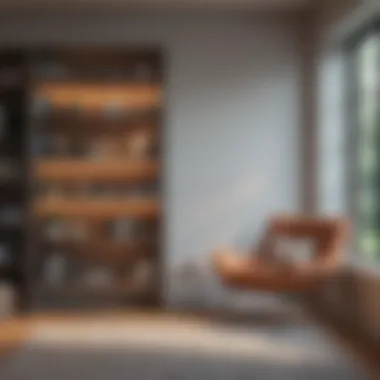
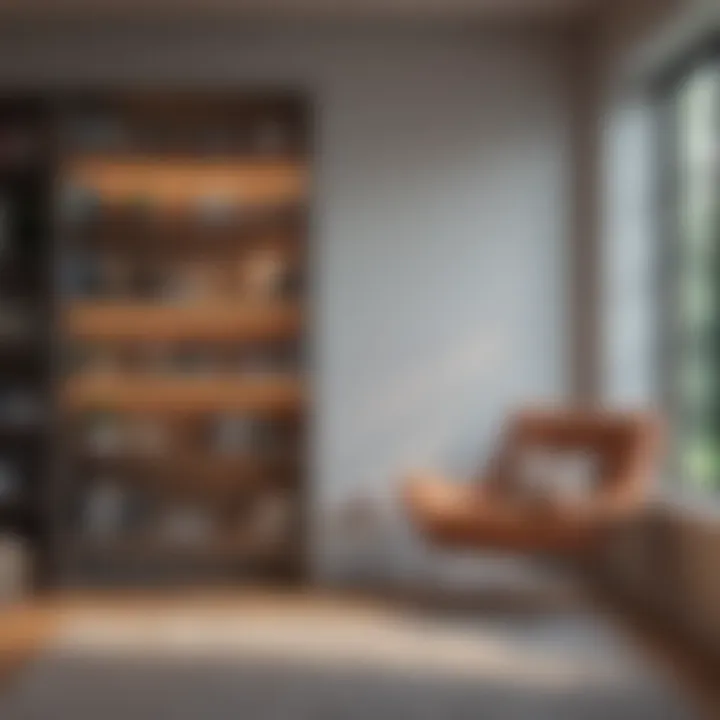
- Strategic Layout: Positioning books by size, genre, or color can enhance visual appeal while remaining functional for retrieval. Tackling display can also include floating shelves, offering a breezy look without overcrowding the space.
- Incorporate Hidden Storage: Use containers or boxes that blend in with the bookshelf design. This allows for a clean appearance while still accommodating items that don’t fit the aesthetic yet are necessary.
- Versatile Materials: Light woods or metals can create an airy feel and are often easier to match with other decor styles, ensuring that your shelving doesn’t become a design liability.
Maintaining this balance involves a thoughtful approach to both the functional aspect of storage and the minimalist design philosophy we appreciate. As much as minimalist design advocates for simplicity, it is essential that the items chosen still serve a purpose and enhance everyday life.
"A well-designed minimalist bookshelf is more than just an absence of clutter; it's a carefully curated arrangement that reflects the owner's identity and values."
As you work through the complexities of designing a minimalist bookshelf, remember that challenges are merely stepping stones toward achieving a harmonious space.
Case Studies: Successful Minimalist Bookshelves
When discussing minimalist bookshelves, examining real-world examples sheds light on the effective marriage of aesthetic and functionality. Case studies not only provide insight into design principles but illustrate how simplicity speaks volumes in both residential and commercial spaces. These examples highlight key considerations, practical applications, and prevailing trends that influence contemporary bookshelf designs.
Residential Applications
In residential settings, minimalist bookshelves often serve as more than just storage; they transform into focal points that can enhance the overall vibe of a room. One notable example is found in modern urban apartments. Here, you might encounter a bookshelf that spans an entire wall, constructed from reclaimed wood and painted in neutral tones. The visual appeal arises from carefully curated items—each book and decor piece on display creating a dialogue without overwhelming the eyes.
In such settings, homeowners are reminded that less can indeed be more.
- The choice of color is at the forefront, typically ehhito not distract from the overall look,
- A blend of vertical and horizontal shelving creates an interesting look while ensuring practicality.
Furthermore, smaller bookshelves certainly don’t fall short. Consider a quaint nook under a staircase that embraces a few select titles alongside small plants and artwork. This use of space not only maximizes square footage but also injects life into otherwise unutilized areas. In a way, those shelves become a narrative of personal experiences through literature and art.
Commercial and Public Spaces
Commercial spaces, such as cafes and co-working environments, also reap the rewards of minimalist shelving. These bookshelves can foster a welcoming atmosphere while maintaining a clean and orderly presentation. For instance, a bustling cafe might incorporate sleek, wall-mounted bookshelves filled with vibrant travelogues and inspiring self-help books. This kind of arrangement encourages patrons to linger, providing comfort through accessible reading materials.
When considering public spaces like libraries, a minimalist approach ensures clarity and ease of navigation. Traditional shelving units may be replaced with modular, open designs that allow for efficient use of light and space. With the right arrangement, libraries can lead visitors to desired genres without overwhelming them with visual clutter. Simple signage paired with a logical categorization can make even the busiest libraries feel zen—inviting in a calm, organized manner.
Both residential and commercial examples illustrate how well-thought-out minimalism positively impacts atmosphere, functionality, and user experience. The elegance of a well-curated bookshelf, regardless of location, underscores why thoughtful design is essential.
Future Trends in Minimalist Bookshelf Design
The world of design is constantly evolving, and the future of minimalist bookshelves is no exception. It’s not just about having a clean look anymore; it’s about how functionality, sustainability, and smart technology shape our interaction with our living spaces. Exploring these future trends is critical not only for homeowners looking for stylish solutions but also for designers who want to keep their work relevant and impactful.
Sustainable Materials and Practices
In an age where environmental consciousness is rising, sustainable materials have become increasingly vital in design. Homeowners are looking beyond mere aesthetics.
Key Elements of Sustainable Practices:
- Recycled Materials: Using recycled wood or metal in bookshelves can minimize the carbon footprint. This ties into a broader movement, where reclaiming materials breathes new life into old products, enhancing both beauty and function.
- Eco-Friendly Finishes: Glossy, harmful paints are on their way out. Natural finishes, made from plant-based substances, not only reduce toxicity but also offer a unique texture and warmth.
- Sourcing Locally: Designers are now focusing on sourcing materials regionally to reduce transportation emissions and support local economies.
These practices contribute to a bookshelf that is not just functional but also tells a story of responsibility and care for the environment.
Smart Technology Integration
Technology is now a core element in everyday living, and bookshelves are embracing this trend. Imagine bookshelves with built-in charging stations, or even integrated speakers that connect with your smart devices. This movement is about more than just convenience; it’s about creating an interactive environment.
Considerations for Smart Integration:
- LED Lighting: Lighting embedded in shelves can be adjusted remotely, allowing owners to change the ambiance of a room with ease. This doesn’t just serve aesthetics, it can enhance a room’s functionality, providing the right light for reading or displaying artworks.
- Mobile Connectivity: Some shelves now feature apps that can help manage your library, suggesting readings based on your interests or notifying you when books are due back in circulation.
- Space-Saving Solutions: Fold-down bookshelves or adjustable units that shift and adapt to user needs can significantly optimize space without compromising style.
“The future is not about having less, it's about creating more meaning with less.â€
Both sustainable materials and smart integration are set to redefine what a minimalist bookshelf can be. These trends don't merely reflect changes in consumer preferences; they symbolize a broader cultural shift toward mindful living, prioritizing quality and adaptability in our spaces.
Epilogue: The Lasting Appeal of Minimalism
Minimalism, particularly expressed through bookshelves, has a relevance that far extends beyond mere storage solutions. It embodies a philosophy of life that resonates with many in today’s fast-paced world, where clutter tends to distract and overwhelm. In this swirling chaos, a minimalist bookshelf delivers clarity, purpose, and intention.
Reflecting on Personal Aesthetics
The heart of minimalism lies in the idea of choosing wisely. When curating a bookshelf, individuals are not just selecting functional pieces; they’re reflecting their personal aesthetics. Each book and item displayed becomes a representation of values, interests, and journeys—a tangible narrative crafted from intentional selections.
- Evaluating Personal Values
This journey often begins with a deep dive into one's own values and aesthetic preferences. For many, this can be about finding a harmonious balance between function and style. Knowing what truly resonates can be the key to achieving a minimalist look that still feels inviting and personal. - Creating a Cohesive Look
The idea of a cohesive look can also influence the aesthetic appeal of a minimalist bookshelf. Choosing books and decor that align with a particular theme or color palette can create stunning visual harmony. Take, for example, a serene collection of monochrome books paired with a few understated decorative objects. This not only serves a utilitarian purpose but also elevates the ambiance of the space, enriching the overall home experience. - Enjoying the Beauty in Simplicity
Moreover, reflecting on personal aesthetics allows individuals to appreciate the beauty that comes with simplicity. In a world filled with distractions, a minimalist bookshelf serves as a reminder that less can indeed be more. It can help create a calming environment where the individual can escape into their favorite literature without interference from excess.
In wrapping up, the lasting appeal of minimalism—particularly with the lens of bookshelves—stands rooted in the narratives we choose to showcase in our spaces. A minimalist bookshelf invites introspection and appreciation for the art of living with less. It challenges us to evaluate not only what we keep, but why we keep it, reinforcing how our environments can reflect our deeper selves.
"In the world of design, simplicity is the ultimate sophistication."
Embracing minimalism may just be one of the best decisions for anyone looking to enhance not only their living space but their overall well-being. Organizing thoughts, ideas, and even emotions becomes much easier when surrounded by a thoughtfully curated approach to design.















